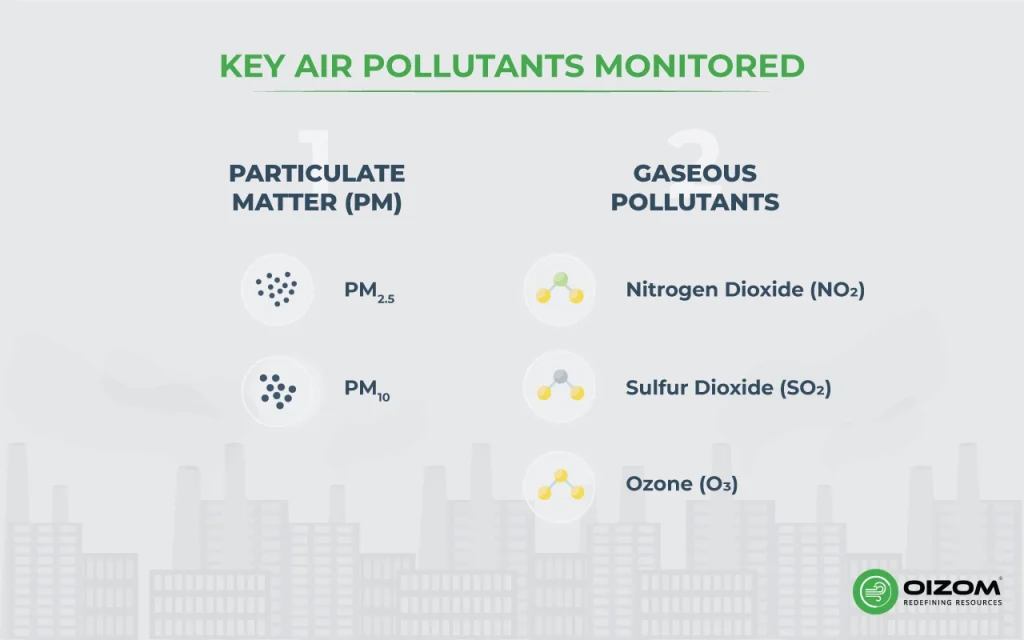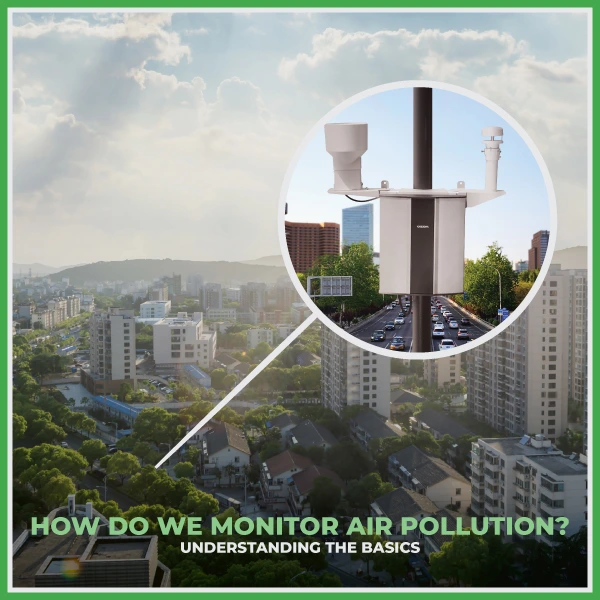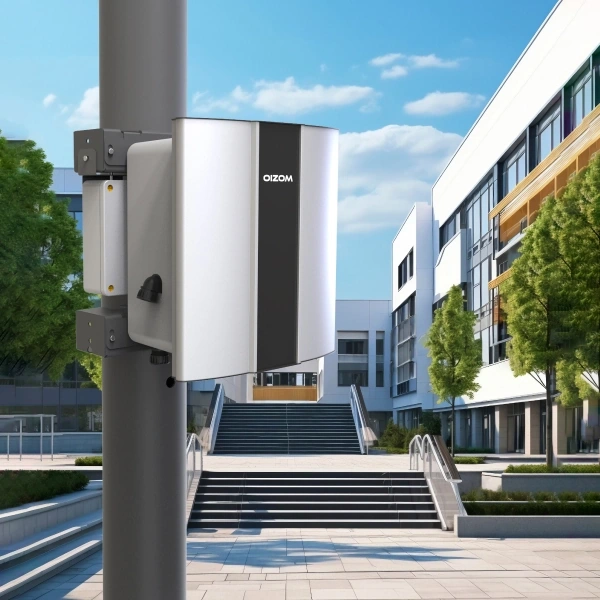Key Takeaway
- Importance of Air Quality Monitoring: Monitoring air pollution is crucial for protecting public health and the environment and ensuring sustainable urban planning.
- Air Quality Instruments: Tools like certified reference, equivalent, and indicative instruments offer varying levels of accuracy for monitoring pollutants like PM2.5, PM10, NO₂, SO₂, and O₃.
- Key Pollutants: Air quality monitoring focuses on harmful pollutants, including particulate matter (PM2.5, PM10), nitrogen dioxide (NO₂), sulfur dioxide (SO₂), and ozone (O₃), which severely impact human health.
- Technology in Action: IoT-enabled air quality sensors, such as Oizom’s Polludrone and Dustroid, offer real-time pollution data, helping businesses and governments manage air quality more effectively.
- Monitoring for All: Affordable and accessible air quality monitors allow individuals, businesses, and governments to track pollution trends and take actionable steps to reduce emissions.
How do we monitor air pollution? Understanding the Basics.
Air quality worldwide continues to degrade as emissions rise, endangering human health and contributing to climate change, biodiversity loss, pollution, and waste. Monitoring air pollution is crucial today, where air quality is directly linked to public health, environmental sustainability, and overall well-being. From harmful gases like carbon monoxide and nitrogen dioxide to particulate matter (PM2.5 and PM10), air pollutants can severely impact our lungs, heart, and environment. But how do we actually monitor these pollutants?
Let me share a quick fact on why air quality monitoring is important. Were you aware of this? According to the Health Effects Institute, air pollution is now the second leading risk factor for death worldwide. Sharing knowledge and learning is crucial to strengthening the movement for clean air.
Air pollution monitoring involves using advanced technologies and devices, such as air quality sensors and analyzers, to detect and measure different pollutants in the air. These devices can be installed in cities, industrial areas, or even indoors to track levels of pollutants in real-time. Continuous monitoring helps us understand the sources of pollution, track trends, and take timely action to reduce harmful emissions. This blog will discuss the importance of monitoring air pollution with air quality instruments and how key pollutants are monitored.
Air quality instruments
Air quality monitoring systems function as a network of specialized equipment. That regularly examines the air for harmful substances such as dust and gases. They provide real-time information about how clean or impure the air is, allowing us to determine if it is safe to breathe. This enables governments, scientists, and everyone else to determine where pollution originates and whether our efforts to clean the air are effective. The information they collect enables us to make informed decisions to protect our health. In addition, we must protect the environment and improve city planning to combat air pollution.
Air quality instruments can be grouped into four classes:
- Certified reference
- Certified equivalent
- Certified indicative
- Indicative.
Certified reference
These instruments provide the highest level of accuracy and are used as benchmarks for validating and calibrating other air quality monitoring devices. They are rigorously tested and certified by recognized standards organizations to ensure precise, traceable measurements.
Certified equivalent
These instruments are nearly as accurate as certified reference devices but are more flexible and cost-effective for widespread monitoring. They meet specific regulatory requirements and offer reliable results for compliance with air quality standards.
Certified indicative
These instruments provide a balance between cost and accuracy. While they do not offer the same precision as reference or equivalent instruments, they are certified to give useful indicative measurements for trends and analysis in less critical applications.
Indicative
These are lower-cost instruments that provide general information on air quality. While less accurate, they are widely used for non-regulatory purposes like community monitoring and public awareness.
Key Air Pollutants Monitored

Air quality monitoring focuses on a few important contaminants that seriously affect health and the environment. This includes:
Particulate Matter (PM)
So, what characteristics do particle matter have? According to the USEPA, particulate matter (PM) is a mixture of solid particles and liquid droplets in the air. Some particles, such as dust and dirt, are visible to the human eye, while others are so minute that they can only be seen with a microscope. They are collectively responsible for all the particle pollution we see daily.
The consequences of particulate matter on human health vary with particle diameter, which is why monitoring different particle sizes, such as PM2.5 and PM10, is crucial.
PM2.5 and PM10
PM10 and PM2.5 are smaller than their effective aerodynamic diameters of 10 and 2.5 micrometers, respectively. As a result, all combustion activities, including vehicle emissions and forest fires, produce considerable amounts of particulate matter (PM).
Secondary complex interactions with other pollutants, such as sulfur dioxide and nitrogen oxides, are widespread and serve as indirect generators of particulate matter. Additionally, dust and particulate pollution are caused by construction and mining activities, as well as unpaved roadways.
There is a famous saying that “You cannot manage what you cannot measure.”. Whether you’re managing construction sites, mines, or ports, we’ve got your air quality covered, from the tiniest PM1 particles to the largest PM100. Dustroid is the perfect solution for businesses that need precise dust monitoring. With Dustroid, you can measure dust particles in real-time and take immediate action, or even better, let the system handle it automatically. It’s all about making dust management easier and more efficient.
Gaseous Pollutants
In addition to particulate matter, air quality monitoring also focuses on key gaseous pollutants that pose significant risks to health and the environment. These include:
Nitrogen Dioxide (NO2)
Nitrogen dioxide, or NO2, is a gaseous air pollutant made up of nitrogen and oxygen. It is part of a group of gases known as nitrogen oxides, or NOx. Nitrogen dioxide is produced when fossil fuels like coal, oil, methane gas (natural gas), or diesel are burned at high temperatures. NO2 and other nitrogen oxides in outdoor air contribute to particle pollution and the chemical processes that produce ozone.
It is a respiratory irritant that can exacerbate the symptoms of an existing respiratory infection. Nitrogen dioxide increases the susceptibility of asthmatics to lung infections and asthma triggers such as pollen and exercise.
Sulfur Dioxide (SO2)
Sulfur dioxide is a respiratory irritant that can exacerbate a more serious respiratory illness. Humans primarily produce sulfur dioxide through the smelting of sulfur-containing mineral ores and the combustion of fossil fuels.
The main source of SO2 in the atmosphere is the combustion of fossil fuels in power plants and other industrial facilities. Smaller sources of SO2 emissions include industrial activities like metal extraction from ore, natural sources like volcanoes, and locomotives, ships, and other vehicles and heavy equipment that run on sulfur-rich gasoline.
Ozone (O3)
Ground-level ozone is a colorless, gaseous secondary pollutant. It is created through chemical interactions between volatile organic compounds (VOCs) and nitrogen oxides in sunshine. Ozone is a fundamental component of atmospheric photochemical smog, which harms human health.
Because its creation is influenced by the availability of UV light and higher temperatures, its concentrations are higher in the summer and typically peak in the afternoons and early evening.
Ozone is a lung irritant that affects lung function and can worsen asthma. You may notice difficulty breathing, coughing, and throat irritation if you exercise outdoors with high ozone levels.
Conclusion
In summary, Air pollution monitoring system is critical for tackling air pollution’s health and environmental risks. By constructing well-designed air quality monitoring networks, we can accurately capture the state of the air and seek to reduce pollution exposure.
What’s nice is that air pollution monitoring is no longer just for major organizations; affordable, IoT-enabled sensors have made it available to everyone. This translates to more data, better insights with the help of Data Analytics, and faster solutions to preserve the air we breathe. Whether on a building site, an industrial facility, or even residential neighborhoods.
As we continue to innovate and enhance air monitoring systems, the potential for reducing pollution and its negative impacts grows stronger. By staying informed and using the right tools, we can make meaningful progress—perhaps even emulate the practices of the least polluted cities in India, which show us that clean air is an achievable goal. Together, we can secure a healthier, more sustainable future.
FAQs
Air pollution is measured with devices like air quality monitors, such as Oizom’s Polludrone, that detect pollutants like PM2.5, NO₂, CO, and O₃ and other environmental parameters.
Wearable sensors and portable air quality monitors track personal exposure to pollutants throughout the day.
Pollutants are tested using sensors for real-time data or through lab analysis of air samples for particulate matter and gases.






